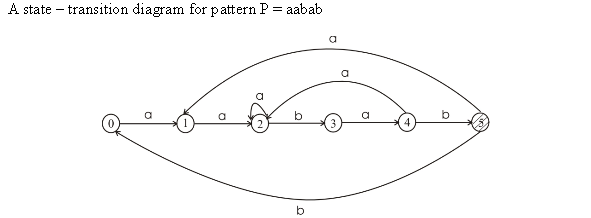The state transition diagram for a string matching automaton for
the pattern ababbabbababbababbabb over the alphabet
 is
as follows:
is
as follows:
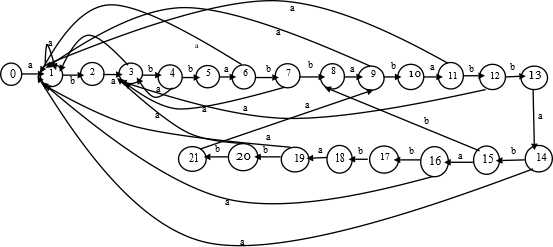
The above transition diagram can be used to show the pattern ababbabbababbababbabb.
Here, first the simple transitions take place from the states 0, 1, 2,3….21 to traverse the entire string. Then, at each transition possibilities are detected to traverse the string.
String Matching Automaton for a Non-Overlappable Pattern
Normally a transition function is computed of a string matching automaton by the algorithm mentioned below. Consider the following algorithm computing transition function from a pattern:
COMPUTE_TRANSITION_FUNCTION (P, )
)
// m is the length of the string
1. 
//Use of for loop which will examine character stored in string
2. for 
//Use of for loop to perform operation on character
3. for every character a in 
// +1 for x, +2 for subsequent repeat loop to decrement
4. k = min(m+1, q+2); // work backwards from q+1
5. repeat
6. 
//condition for termination of repeat
7. until ;
;
8.  (q,
a) = k;
(q,
a) = k;
//return the value of 
9. return  ;
;
Consider the state transition diagram:

This diagram shows the automaton of the string with 'm' number of states where p0, p1, p2, …, pm are the elements or characters of the string which when seen gets accepted and enters into the next state example on seeing p0 the automaton is shifted from state 0 to state 1.For an non overlapping pattern string,
Consider P = p0, p1, p2 ……... pm
The specific feature of a nonoverlappable pattern is that its
proper pre?x are not its su?x. This property is used for describing
the destination of the outgoing arrow. For every pair , labeling
of state q by a will be there.
, labeling
of state q by a will be there.
As per the algorithm, the destination state k can be defined as:
1. When  and
and :
In this case, the value of k will be 1 more than the value
of q. This can be given as:
:
In this case, the value of k will be 1 more than the value
of q. This can be given as: .
.
2. When :
When the value of a is equal to p1, then
the value of k is set to 1. So, this condition will make the
value of k equal to 1.
:
When the value of a is equal to p1, then
the value of k is set to 1. So, this condition will make the
value of k equal to 1.
3. If any other condition arises: If both conditions given above are not satisfied, then the value of k is set to 0.
All the cases mentioned above can be shown as:

When case 1 is satisfied, then the value  is obtained
by using following equations:
is obtained
by using following equations:



The arrow will be from state q to state .
.
Now, denoting the value of k as:

It is clear from the above equation that  is a su?x
of
is a su?x
of  a.
a.
When the value of , then it is
found that
, then it is
found that  is a suffix
of
is a suffix
of .
For any of the non-overlappable pattern, this condition is
impossible. So, the value of k will be either equal to 1 or
less than 1. This means that the outgoing arrow having label
a and from state q will either leads to state 1 or
state 0. The outgoing arrow will lead to state 1 if condition given
below will be satisfied:
.
For any of the non-overlappable pattern, this condition is
impossible. So, the value of k will be either equal to 1 or
less than 1. This means that the outgoing arrow having label
a and from state q will either leads to state 1 or
state 0. The outgoing arrow will lead to state 1 if condition given
below will be satisfied:

The equation given above means that  and it is a
suffix of
and it is a
suffix of . In other
words, the value of a is equal to p1.
. In other
words, the value of a is equal to p1.
Construct the automata as follows:
Let  be the
longest prefix which is common in both P and
be the
longest prefix which is common in both P and  . Create the
automaton A for
. Create the
automaton A for  .
.
Construct an arrow from the state labelled k to the chain of
states k+1, k+2, k+3……|P| and draw the necessary arrows so that the
transition is  .
.
For the pattern  , show the
transition from the state labelled
, show the
transition from the state labelled  to chain of
states
to chain of
states  ,
, ,
, …..
….. .
.
The transition for the pattern  is
is  ……(refer
Theorem 32.4 of textbook)
……(refer
Theorem 32.4 of textbook)
The finite automata that determines the occurrences of either pattern can be shown below:
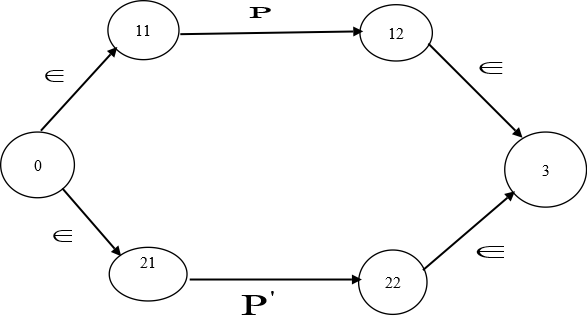
The transition from the first state to the intermediate states is shown in the following way:
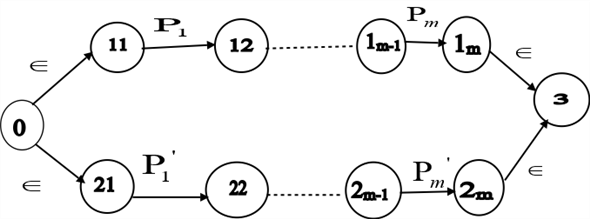
The minimization of the number of the states in the automaton is
done by eliminating the null states that is,  which can
be shown in the following way:
which can
be shown in the following way:
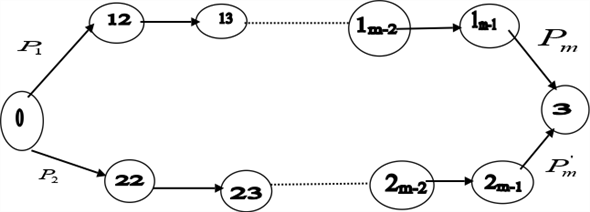
Thus, the states are expanded in the following way as:
11,12…… for the
pattern P and as: 21,22….
for the
pattern P and as: 21,22…. for the
pattern
for the
pattern  and on
minimizing the null state each transition is shifted before by one
step.
and on
minimizing the null state each transition is shifted before by one
step.
Consider the pattern  which
contains gap characters.
which
contains gap characters.
Let  be the
text.
be the
text.
Find the occurrence of the pattern  in text
in text
 .
.
Find the occurrence of pattern  in text
in text
 using the
following steps:
using the
following steps:
• Divide pattern  into
substrings
into
substrings  based on
the gap character.
based on
the gap character.
• Compare the sub pattern  with text
with text
 .
If
.
If  does not match with text
does not match with text  , then the
pattern does not match with text
, then the
pattern does not match with text  .
.
• If pattern  is found in
text
is found in
text  , then
compare pattern
, then
compare pattern  in the
remaining part of text
in the
remaining part of text  . If
. If
 does not match with text
does not match with text  , then the
pattern does not match with text
, then the
pattern does not match with text  .
.
• Continue the process till all the patterns up to  are matched
with text
are matched
with text  . The
process of comparison can be terminated at any point when
. The
process of comparison can be terminated at any point when  does not
match with text
does not
match with text  .
.
Construct finite automatons for each  , that
matches the sub pattern
, that
matches the sub pattern  with text
with text
 .
The following is the generalized finite automaton that accepts the
string
.
The following is the generalized finite automaton that accepts the
string  if it
matches with text
if it
matches with text  :
:

Combine all the finite automatons that accept the sub pattern
 ,
with text
,
with text  . Also, the
accepting state of
. Also, the
accepting state of , where
, where
 ,
is no longer accepting the pattern, but has a single transition to
,
is no longer accepting the pattern, but has a single transition to
 .
.
The following is the generalized finite automaton to find the
occurrence of pattern  in text
in text
 :
:

Each finite automaton requires at least  matches and
at most
matches and
at most  matches to
verify that sub pattern
matches to
verify that sub pattern  matches
with text
matches
with text  .
.
Overall, the number of matches required will be equal to
 or
or
 in
worst case.
in
worst case.
However,  .
.
Hence, the maximum number of matchings required is  .
.
Therefore, the sequentially combined finite automaton is the
required finite automaton that can find an occurrence of
 in a
text
in a
text  in
in  matching time, where
matching time, where  .
.
